Beautiful French actress Annie Ducaux (1908-1996) appeared in 40 film and television productions between 1932 and 1980. Ducaux was also Sociétaire (shareholder) of the prestigious state theatre La Comédie-Française from 1946 to 1982 and performed in countless stage plays. She is possibly best remembered for her roles in such films as Abel Gance's Un grand amour de Beethoven/Beethoven's Great Love (1937) and Les Grandes Familles/The Possessors (1958), as the wife of Jean Gabin.
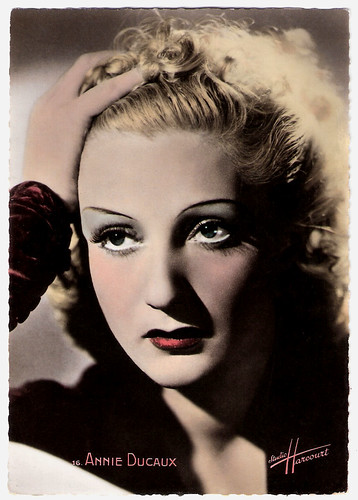
French postcard by GREFF, S.E.R.P., Paris, no. 16. Photo: Studio Harcourt.
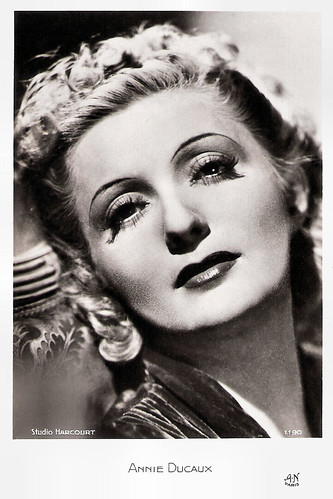
French postcard by A.N., Paris, no. 1190. Photo: Studio Harcourt.
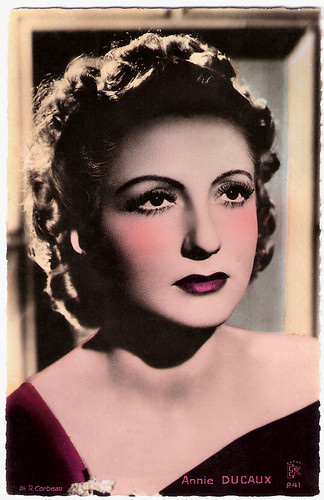
French postcard by Editions et Publications Cinematographiques (EPC), Paris, no. 241. Photo: R. Corbeau.
Anne Marie Catherine Ducaux was born in Besançon, France in 1908. The long and elegant blonde won the first prize at the Conservatoire. At 24, she made her cinema debut in the crime film Coupe de feu à l’aube/Shot at Dawn (Serge de Poligny, 1932), in which she immediately had the female lead of Irene Taft opposite Jean Galland. It was the French version of the Ufa production Schuss im morgengrauen (Alfred Zeisler, 1932), which was simultaneously filmed in the Babelberg studios in Berlin.
This was followed by parts in the comedies Le gendre du Monsieur Poirier/The Son-in-law of Mister Poirier (Marcel Pagnol, 1933) and Le fakir du Grand Hotel/The Wizard of Grand Hotel (Pierre Billon, 1933), the Jules Claretie adaptation Le petit Jacques/Little Jack (Gaston Roudès, 1934), and Cessez le feu/Cease Firing (Jacques de Baroncelli, 1934) with again Galland.
Ducaux was Austrian empress Maria Theresia in Nuit de mai/Night in May (Henri Chomette, Gustav von Ucicky, 1934) opposite Fernand Gravey and Käthe von Nägy. She had the female lead in the Marcel Pagnol adaptation and period piece L’agonie des aigles/The Death Agony of the Eagles (Roger Richebé, 1934) and in the drama Un homme de trop à bord/One Too Many on Board (Gerhard Lamprecht, Roger le Bon, 1935).
In the 1930s almost all of the films in which Ducaux played, had her in the female lead. She was Colette in the Pierre Decourcelle adaptation Les deux gosses/The Two Kids (Fernand Rivers, 1936), Therese of Brunswick in Un grand amour de Beethoven/Beethoven’s Great Love (Abel Gance, 1936) opposite Harry Baur as famous early 19th-century German composer Ludwig van Beethoven, Le voleur de femmes/The Woman Thief (Abel Gance, 1936) opposite Jules Berry, the heroine of Les filles du Rhône/The Girls from the Rhône (Jean-Paul Paulin, 1937), and the prison director Yvonne in Prison sans barreaux/Prison Without Bars (Léonide Moguy, 1937) costarring Roger Duchesne and Corinne Luchaire. Subsequent films with Ducaux in the lead were Moguy’s drama Conflit/Affair Lafont (Léonide Moguy, 1938), La vierge folle/A Foolish Maiden (Henri Diamant-Berger, 1938), and L’homme du Niger/Forbidden Love (Jacques de Baroncelli, 1939).
Ducaux costarred with Arletty, Marcel Dalio and Erich von Stroheim in Tempête/Thunder Over Paris (Dominique Bernard-Deschamps, 1939), and with Pierre Blanchar in L’empreinte du Dieu/Two Women (Léonide Moguy, 1939). Her subsequent films from the war years were Dernière aventure/Last Adventure (Robert Péguy, 1941), Pontcarral, colonel d’empire/Pontcarral, Colonel of the Empire (Jean Delannoy, 1942) again with Blanchar, L’inévitable M. Dubois/The Inevitable Mr Dubois (Pierre Billon, 1942), Le bal des passants/The Ball of the Passers-by (Guillaume Radot, 1943), and Florence est folle/Florence is Crazy (Georges Lacombe, 1944).
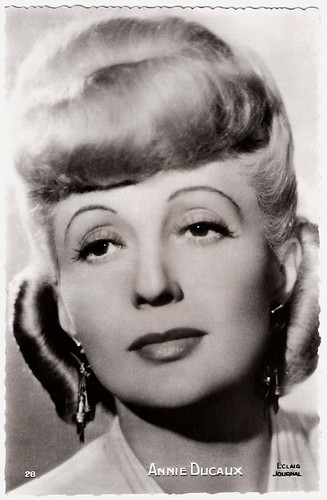
French postcard. Photo: Eclair Journal, no. 28.

French postcard by Editions P.I., Paris, no. 28.
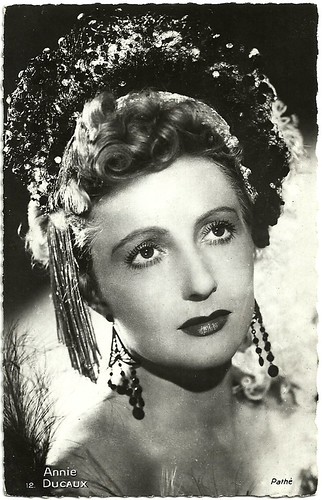
French postcard, no. 12. Photo: Pathé.
After a small part in the Victorien Sardou adaptation Patrie/Homeland (Louis Daquin, 1946), Annie Ducaux’s real post-war comeback in the cinema was as Countess Marie d’Agoult in the Franz Liszt biopic Rêves d’amour/Dreams of Love (Christian Stengel, 1946) starring Pierre-Richard Willm as the composer.
Next followed the female leads in the tragicomedy Rendez-vous à Paris/Rendezvous in Paris (Gilles Grangier, 1946), the spy story Les requins de Gibraltar/The Sharks of Gibraltar (Emil E. Reinert, 1947), the comedy La patronne/The Patron (Robert Dhéry, 1949), and the comedy Le roi/The King (Marc-Gilbert Sauvajon, 1949) opposite Maurice Chevalier as the King. In 1946, she had joined La Comédie-Française and stayed there for 35 years. There she went from triumph to triumph. From 1948 till 1982, she was sociétaire, then sociétaire honoraire (honorary shareholder), commandeur de la Légion d'honneur (Commander of the Legion of Honour) and officier des arts et des lettres (Officer of the Order of Arts and Letters).
After 1949 Ducaux focused on her stage work and was away from the screen for almost a decade. In 1957 she played Queen Marie Antoinette in the episode La mort de Marie Antoinette/The Death of Marie Antoinette of the TV series La caméra explore le temps/The camera investigates the time (Stellio Lorenzi, 1957-1958). She would again play the queen in 1963 in the TV series Le chevalier de Maison-Rouge/The Knight of the Red House, directed by Claude Barma and based on a novel by Alexandre Dumas père. The chevalier himself was performed by Jean Desailly.
At the cinema, Ducaux played again with Desailly and Jean Gabin in the family seriocomedy Les grandes familles/The Possessors (Denys de la Patellière, 1958). During the 1960s, roles followed in the period piece La princesse de Cleves/Princess of Cleves (Jean Delannoy, 1960) in which Ducaux was Diane de Poitiers and Jean Marais was her costar, and the comedy La belle Américaine/The American Beauty (Robert Dhéry, Pierre Tchernia, 1961) with Robert Dhéry himself in the lead.
After that Ducaux did no cinema films anymore, only TV work. Le chevalier de Maison-Rouge was followed by Electre/Electra (Pierre Dux, 1972), the Molière adaptation Les femmes savants/The women scholars (Jean Vernier, 1972), the Henry James adaptation Les ailes de la colombe/The wings of the dove (Daniel Georgeot, 1975), and the Jean Giraudoux adaptation La folle de Chaillot/The Madwoman of Chaillot (Georges Paumier, 1980). Her last screen part was in the episode Maigret et l’ambassadeur/Maigret and the Ambassador (Stéphane Bertin, 1980) of the TV series Les enquêtes du commissaire Maigret/The inquiries of the inspector Maigret (1967-1990) starring Jean Richard. At the age of 88, Annie Ducaux died in Champeaux, France in 1996. She was married to the Swiss film producer Ernest Rupp. She had one child, the French film producer Gérard Ducaux-Rupp.
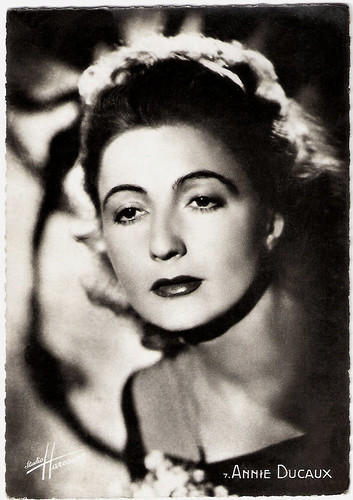
French postcard by S.E.R.P., Paris, no. 7. Photo: Studio Harcourt.
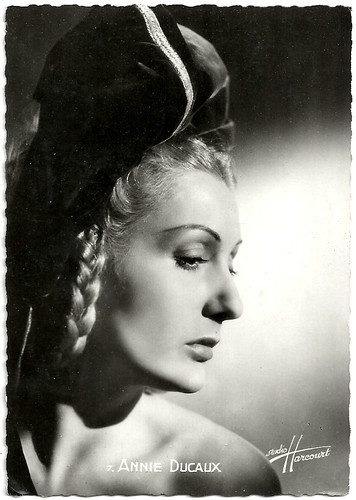
French postcard. Photo: Studio Harcourt.
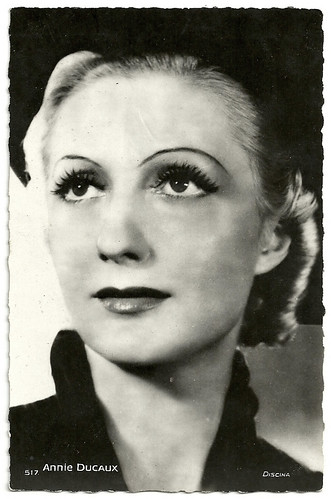
French postcard, no. 517. Photo: Discina.

French postcard, no. 517. Photo: Lipnitzky. Collection: Didier Hanson.
Sources: Céline Colassin (CinéArtistes - French), Bifi (French), Wikipedia (English and French), and IMDb.
This post was last updated on 31 January 2024.

French postcard by GREFF, S.E.R.P., Paris, no. 16. Photo: Studio Harcourt.

French postcard by A.N., Paris, no. 1190. Photo: Studio Harcourt.

French postcard by Editions et Publications Cinematographiques (EPC), Paris, no. 241. Photo: R. Corbeau.
Beethoven’s great love
Anne Marie Catherine Ducaux was born in Besançon, France in 1908. The long and elegant blonde won the first prize at the Conservatoire. At 24, she made her cinema debut in the crime film Coupe de feu à l’aube/Shot at Dawn (Serge de Poligny, 1932), in which she immediately had the female lead of Irene Taft opposite Jean Galland. It was the French version of the Ufa production Schuss im morgengrauen (Alfred Zeisler, 1932), which was simultaneously filmed in the Babelberg studios in Berlin.
This was followed by parts in the comedies Le gendre du Monsieur Poirier/The Son-in-law of Mister Poirier (Marcel Pagnol, 1933) and Le fakir du Grand Hotel/The Wizard of Grand Hotel (Pierre Billon, 1933), the Jules Claretie adaptation Le petit Jacques/Little Jack (Gaston Roudès, 1934), and Cessez le feu/Cease Firing (Jacques de Baroncelli, 1934) with again Galland.
Ducaux was Austrian empress Maria Theresia in Nuit de mai/Night in May (Henri Chomette, Gustav von Ucicky, 1934) opposite Fernand Gravey and Käthe von Nägy. She had the female lead in the Marcel Pagnol adaptation and period piece L’agonie des aigles/The Death Agony of the Eagles (Roger Richebé, 1934) and in the drama Un homme de trop à bord/One Too Many on Board (Gerhard Lamprecht, Roger le Bon, 1935).
In the 1930s almost all of the films in which Ducaux played, had her in the female lead. She was Colette in the Pierre Decourcelle adaptation Les deux gosses/The Two Kids (Fernand Rivers, 1936), Therese of Brunswick in Un grand amour de Beethoven/Beethoven’s Great Love (Abel Gance, 1936) opposite Harry Baur as famous early 19th-century German composer Ludwig van Beethoven, Le voleur de femmes/The Woman Thief (Abel Gance, 1936) opposite Jules Berry, the heroine of Les filles du Rhône/The Girls from the Rhône (Jean-Paul Paulin, 1937), and the prison director Yvonne in Prison sans barreaux/Prison Without Bars (Léonide Moguy, 1937) costarring Roger Duchesne and Corinne Luchaire. Subsequent films with Ducaux in the lead were Moguy’s drama Conflit/Affair Lafont (Léonide Moguy, 1938), La vierge folle/A Foolish Maiden (Henri Diamant-Berger, 1938), and L’homme du Niger/Forbidden Love (Jacques de Baroncelli, 1939).
Ducaux costarred with Arletty, Marcel Dalio and Erich von Stroheim in Tempête/Thunder Over Paris (Dominique Bernard-Deschamps, 1939), and with Pierre Blanchar in L’empreinte du Dieu/Two Women (Léonide Moguy, 1939). Her subsequent films from the war years were Dernière aventure/Last Adventure (Robert Péguy, 1941), Pontcarral, colonel d’empire/Pontcarral, Colonel of the Empire (Jean Delannoy, 1942) again with Blanchar, L’inévitable M. Dubois/The Inevitable Mr Dubois (Pierre Billon, 1942), Le bal des passants/The Ball of the Passers-by (Guillaume Radot, 1943), and Florence est folle/Florence is Crazy (Georges Lacombe, 1944).

French postcard. Photo: Eclair Journal, no. 28.

French postcard by Editions P.I., Paris, no. 28.

French postcard, no. 12. Photo: Pathé.
Marie Antoinette
After a small part in the Victorien Sardou adaptation Patrie/Homeland (Louis Daquin, 1946), Annie Ducaux’s real post-war comeback in the cinema was as Countess Marie d’Agoult in the Franz Liszt biopic Rêves d’amour/Dreams of Love (Christian Stengel, 1946) starring Pierre-Richard Willm as the composer.
Next followed the female leads in the tragicomedy Rendez-vous à Paris/Rendezvous in Paris (Gilles Grangier, 1946), the spy story Les requins de Gibraltar/The Sharks of Gibraltar (Emil E. Reinert, 1947), the comedy La patronne/The Patron (Robert Dhéry, 1949), and the comedy Le roi/The King (Marc-Gilbert Sauvajon, 1949) opposite Maurice Chevalier as the King. In 1946, she had joined La Comédie-Française and stayed there for 35 years. There she went from triumph to triumph. From 1948 till 1982, she was sociétaire, then sociétaire honoraire (honorary shareholder), commandeur de la Légion d'honneur (Commander of the Legion of Honour) and officier des arts et des lettres (Officer of the Order of Arts and Letters).
After 1949 Ducaux focused on her stage work and was away from the screen for almost a decade. In 1957 she played Queen Marie Antoinette in the episode La mort de Marie Antoinette/The Death of Marie Antoinette of the TV series La caméra explore le temps/The camera investigates the time (Stellio Lorenzi, 1957-1958). She would again play the queen in 1963 in the TV series Le chevalier de Maison-Rouge/The Knight of the Red House, directed by Claude Barma and based on a novel by Alexandre Dumas père. The chevalier himself was performed by Jean Desailly.
At the cinema, Ducaux played again with Desailly and Jean Gabin in the family seriocomedy Les grandes familles/The Possessors (Denys de la Patellière, 1958). During the 1960s, roles followed in the period piece La princesse de Cleves/Princess of Cleves (Jean Delannoy, 1960) in which Ducaux was Diane de Poitiers and Jean Marais was her costar, and the comedy La belle Américaine/The American Beauty (Robert Dhéry, Pierre Tchernia, 1961) with Robert Dhéry himself in the lead.
After that Ducaux did no cinema films anymore, only TV work. Le chevalier de Maison-Rouge was followed by Electre/Electra (Pierre Dux, 1972), the Molière adaptation Les femmes savants/The women scholars (Jean Vernier, 1972), the Henry James adaptation Les ailes de la colombe/The wings of the dove (Daniel Georgeot, 1975), and the Jean Giraudoux adaptation La folle de Chaillot/The Madwoman of Chaillot (Georges Paumier, 1980). Her last screen part was in the episode Maigret et l’ambassadeur/Maigret and the Ambassador (Stéphane Bertin, 1980) of the TV series Les enquêtes du commissaire Maigret/The inquiries of the inspector Maigret (1967-1990) starring Jean Richard. At the age of 88, Annie Ducaux died in Champeaux, France in 1996. She was married to the Swiss film producer Ernest Rupp. She had one child, the French film producer Gérard Ducaux-Rupp.

French postcard by S.E.R.P., Paris, no. 7. Photo: Studio Harcourt.

French postcard. Photo: Studio Harcourt.

French postcard, no. 517. Photo: Discina.

French postcard, no. 517. Photo: Lipnitzky. Collection: Didier Hanson.
Sources: Céline Colassin (CinéArtistes - French), Bifi (French), Wikipedia (English and French), and IMDb.
This post was last updated on 31 January 2024.
No comments:
Post a Comment